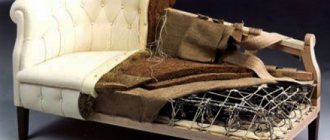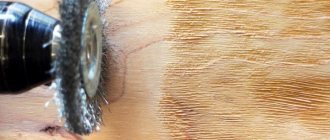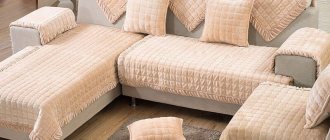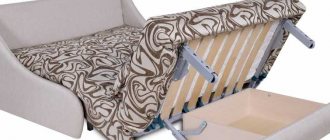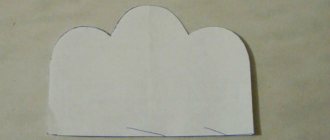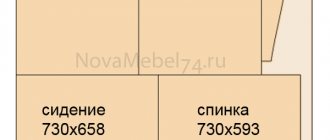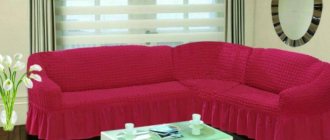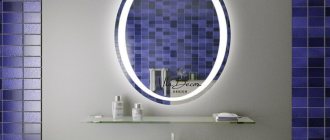In stores you can find a huge number of textile products of any shape, made from all kinds of materials. This also applies to bedspreads for beds, sofas, and armchairs. But, unfortunately, there is not always a model that matches furniture of a non-standard shape or size, for example, made to order. In this case, you can try to make a blanket for the sofa with your own hands, matching the color, design and dimensions. You should first think through all the details, prepare tools, fabric or yarn, and only then start working.
How can you save money?
Material waste is not always compatible with opportunities, so it is better to think about saving. How can this be done? Saving does not mean buying the cheapest and low-quality things. In order for your child to get the best, you need to start calculating your budget correctly, and it is best to start sewing things for children at home.
The easiest way to start saving money is to sew a blanket yourself. On the open market you can find products of this type in different colors, quality and sizes, but marking up the price is not always possible. When ordering in an online store, the markup will be less, but the selected item will not be able to be touched and the color assessed. The best option would be to find the answer to the question of how to sew a children's blanket from plush and cotton (satin) Minky with your own hands. Step-by-step instructions will help you do this quickly and well.
Selecting the color
A well-chosen color scheme and pattern on the bedspread will help to slightly correct the unfortunate shape of the room and diversify it. Cold, dark shades are used in spacious, well-lit rooms with windows facing southeast and south. Lighter, warmer ones are suitable for small bedrooms where the sun rarely penetrates, and the windows are “turned” to the north, northwest.
Stripes directed in the right direction can correct the disproportion of the room, but it is advisable to duplicate the print on other elements of the decor. If the wallpaper, carpets, curtains are colorful, the bedspread is selected in a single color and vice versa. Sometimes the drapery of the bed is made the only color accent of a monochrome interior. Two- or three-color models are most common; overly variegated ones are suitable only for interiors such as boho or oriental.
Most popular colors:
- purple-black;
- slate gray;
- beige;
- terracotta;
- silver brown;
- brilliant blue;
- mahogany;
- golden orange;
- pale pink;
- rich brown;
- creamy white;
- chrome green;
- orchid.
What tools and fabrics to use
To sew a blanket you will need plush and cotton (satin) of good quality. And if you want to sew a winter blanket, you will additionally need to purchase padding polyester. Satin should be chosen because it is a hypoallergenic material that is completely safe for the health of the child, has excellent quality, soft fabric texture, and a noble shine.
To purchase materials, you will need to go to a fabric store or place an order in a trusted online store (we offer only high-quality fabrics from the best domestic and foreign manufacturing companies).
To sew a blanket yourself, you need to arm yourself with the following tools:
- Soap, or, alternatively, a special pencil, with which you make marks on the fabric;
- sewing machine and threads of the appropriate color;
- scissors and measuring tape.
And, of course, the fabric necessary for making the blanket.
Other options
Even within the confines of an extensive article it is impossible to consider all the diversity of this textile. There are quite a lot of bedspreads, all of them are made from natural, artificial and mixed fabrics of suitable quality. A good purchase is distinguished not only by its appearance and characteristics declared by the manufacturer. You should also pay attention to the reputation of the manufacturer, cost and availability of the necessary hygiene certificates.
In addition to the above, you can choose a bedspread from the following fabrics:
- Fleece - inexpensive and very attractive material.
Made from fleece - Satin is a great alternative to silk for summer bedspreads.
- Mako satin is a practical and very beautiful type of fabric. For sewing bedspreads it is used with a lining.
- Cashmere is a warm and very cozy bedspread, but it is expensive.
- Jacquard is a durable fabric with a tight weave.
- Microfiber - excellent characteristics and low cost.
- Velor is a warm and durable fabric with an unusual surface.
- Terry bedspreads come in a variety of shades and perfectly retain heat while sleeping.
The best option for summer use is to choose lighter fabrics, and in winter to lay warmer and more comfortable fabrics. This will help create comfort and extend the life of the selected model.
Features of the fabrics used
Minky Plush is a microfiber material. Soft and gentle, it is pleasant to the body. Thanks to the breathable effect and good heat dissipation, it will warm the baby, but at the same time his body will breathe. The fabric consists of 100% polyester, which is a synthetic material, but this does not mean that it is inferior in quality to natural material. On the contrary, it does not absorb unpleasant odors and does not cause allergies.
The material has a dense structure, so it is almost impossible to tear or deform. After washing it remains the same smooth and does not require ironing. Any stains come off easily even when washed at low temperatures. After numerous washes, its colors will remain just as durable. High-quality plush is produced in American, European, and Chinese factories.
Satin (100% cotton) is a natural hypoallergenic material that allows air to pass through well and allows the skin to breathe. Even if it absorbs 20% moisture, it will still be hygroscopically stable. A huge assortment of shades and various prints presented in our company’s store allows you to choose the most suitable option.
Optimal bedspread size
In order to understand what size bedspread we need, we need to take measurements from the bed itself (length, width). It is worth noting that the product that hangs down from the mattress looks best, so you should add about 60 centimeters to the width of the bed, and 30 centimeters to the length.
An example of a voluminous satin bedspread
How can you sew a minky plush blanket with your own hands?
Before sewing, it is important to rinse the material in water (temperature - 38-400C). If this is done after sewing, it is possible that the product will change its size and become deformed.
Suitable dimensions of a blanket for a baby crib are:
- 100x100 cm;
- 100x110 cm;
- 100x120 cm.
It is possible to sew a blanket in a smaller size, but this will not be practical, since children grow up quickly.
The main stages of preparation for work are as follows:
- the plush fabric should be laid out on the surface (it should be flat);
- draw lines according to the size of the blanket, cutting off the excess ends;
- measure and cut the satin in the same way;
- fold both materials together, right sides inward.
Plush stretches well, so it is better to immediately fasten it with needles or special pins (you can use safety pins) to the edges of the cotton fabric.
Make a basting and sew with a regular seam, making an indentation from the edges - 5-10 cm. Do not forget that there should be a small hole about 15 cm in size, with the help of which our creation can be turned out.
After turning the resulting blanket right side out, the remaining hole will need to be sewn shut on a machine, or, if this option is not possible, sewn up with a secure blind stitch.
This blanket will help your baby feel comfortable on a cool night in the summer. The same blanket can be made for cold weather, only it will differ in density. It retains heat better, and the principle of its manufacture differs only in that padding polyester is added inside.
We cut out identical pieces of all types of material.
We lay the padding polyester, and on it the smooth side is plush, and then satin, always with the front side down.
The edges must be secured with pins so that it is convenient to sew with a regular seam (indentation - 1 centimeter). 20 centimeters should be left unstitched.
All fabrics are sewn on a machine with an indentation of 1 cm
The hole left is necessary in order to carefully turn the blanket inside out, and then sew the unstitched area by hand.
Through the slot, the blanket is carefully turned right side out
This is what a neatly stitched baby blanket looks like.
There is padding inside, which means the materials need to be stitched 1-2 times along the front side. This is also necessary to ensure that the padding polyester does not roll off during washing. A large number of seams will help secure it in one place so that it does not lose its shape after washing.
After turning it right side out, the remaining slit is carefully stitched by hand.
All edges of the blanket are secured with needles or pins.
The blanket is stitched with indentations of 3 cm.
This is what a finished blanket, made with loving hands, looks like for a newborn. Photos clearly express the entire sewing process, and step-by-step instructions help you do it quickly.
Patchwork: if “there are leftovers left”
When the fabric was purchased in large quantities, the remaining material can be used to sew the same decorative pillows for a bed, sofa, or chair. If a large number of pieces have accumulated, then it is advisable to sew a bedspread or blanket from scraps.
In this case, the work does not require the ideal geometry of the pieces. Such products are especially suitable for children. It is also not necessary to quilt them; it is more important to make it colorful, attracting attention, and giving positive emotions. Another thing is patchwork. This bedspread can be the best decoration for the master bedroom.
- First, choose a pattern for the elements. The most inexpensive options are the same rhombuses and squares, the shapes are much more complex - triangles, flowers. For beginners, the best choice is simple elements - squares.
- Buy fabric. For example, for a bed measuring 220x240 cm you will need about 10 meters of base material and multi-colored pieces measuring from 50 to 80 cm. The maximum number of colors is 8. A combination of colorful and plain materials is possible. The only requirement is similar thickness and texture.
- The elements are crafted: small templates are transferred to pieces of fabric, seam allowances are left, and details are cut out.
- Cut a large piece according to the size of the bed, but leave extra centimeters (5-10).
- Try all the pieces on the base material, arrange them depending on your own preferences.
- All the small elements are sewn, then they are distributed and attached to the fabric that serves as the back of the bedspread.
Sometimes they do things differently. Cut out of two parts, completely finished, the elements are sewn not onto the base, but to each other. In this case, the work is simplified, since there will be no difficulties due to the mismatch between the sizes of the base and small elements.
Since sewing a bedspread is not very difficult, there are a lot of options. The choice of model depends only on the level of training of the craftswoman; the algorithm of work differs in small details. Experience comes with practice. After mastering the technique of making simple products, it is easy to “jump” to more complex bedspreads.
This wonderful video will introduce you to all the intricacies of quilting:
Features of caring for a blanket
Plush is a synthetic polyester, so caring for it is easy. But despite this, you should adhere to some useful guidelines:
- Do not use detergents that contain chlorine or bleach;
- Do not dry in direct sunlight;
- the optimal temperature for washing is no more than 30 degrees;
- When washing in a machine, it is better not to wring out the product;
- It is strictly forbidden to boil.
During sewing, it is necessary to cut the plush with extreme caution, since pieces of fabric will fall off, but this fact will not affect the main part of the piece.
Not only blankets are made from minky plush, but also decorative pillows, blankets for adults and children, pillowcases, envelopes for discharge from the maternity ward, pajamas, bathrobes, etc.
Blanket requirements
Before you start sewing, it is better to immediately decide how you want the finished product to look. To do this, it would be more correct to follow some requirements:
- Choose the density based on the temperature of the room in which the item will be used. If you make a mistake with this parameter, the child will either freeze or, conversely, he will be very hot.
- Decide on the size of the blanket. If it is too small, then any movement of the child will expose parts of his body, and he will freeze. If you make a large product, it will hinder children’s movements.
- Sewing a heavy item should be avoided. This is especially true for babies who will simply have difficulty breathing.
- The absence of various decorative elements on the product that pose a potential health hazard.
This might interest you. What are flat-stitch sewing machines
? Important. After the product is ready, you need to remove all protruding threads from it so that the baby does not cut himself on them.


